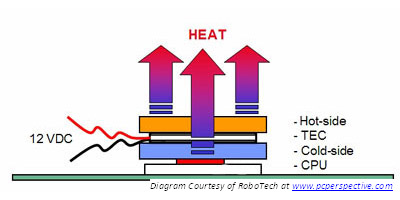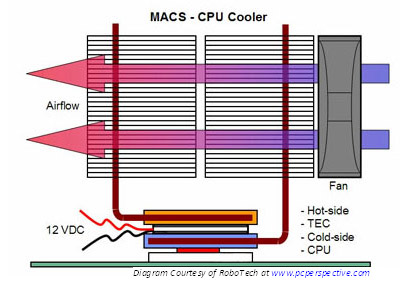Monsoon II Lite: Thermal Electric Cooling Tower
by Wesley Fink on February 6, 2007 6:00 AM EST- Posted in
- Cases/Cooling/PSUs
How the Monsoon II Lite Works
Thermal Electric Cooling is based on a very simple concept. When a low voltage DC current is applied to the junction of two connected dissimilar materials, heat can be moved from one material to the other. One side is cooled (cold plate) and the other side is simultaneously heated (hot side). The temperature differential between the sides can be upwards of 50°C, and the heatpipe/fins arrangement enhances cooling by creating a temperature differential that can be moved out of the system.

You may wonder why this simple concept is not used in every cooling device. It is because things are not as straightforward as they first appear. The cooling process itself is very inefficient, and the Peltier consumes more power than it produces in cooling. In fact it consumes two or three times more power than it delivers in cooling. Another major issue is that during idle and light loads the cool plate and the area around it may suffer from condensation and frost may form. This is one of the reasons phase-change cooling devices are heavily insulated (and expensive).
Another problem that needs to be addressed is the proper sizing of the TEC. If it is too small (low-wattage) it won't be able to keep up with the CPU heat generation; too large and it could rapidly overcool and frost over. Solid state devices like a TEC are very reliable, but another overriding concern is that if anything goes wrong, such as lost power to the Peltier or a broken wire, the Peltier stops pumping heat and becomes an insulator, which could cause a processor failure with no other cooling available.

Vigor believes they have eliminated these problems by combining a medium-power intermittent TEC with an efficient heatpipe cooling tower. The Monsoon II Lite isn't designed for extreme sub-zero overclocking. Instead it is designed as a high-performance Heatsink/Fan with a 25°C target temperature, which is a little higher than ambient room temperature. By limiting the maximum temperature by intermittent operation of the Peltier problems like condensation are no longer an issue.
In addition, the heatpipes are connected to both the cold and the hot plates. This provides Monsoon II an alternate heat-flow path from the vulnerable cold plate, and it protects the processor in the event of TEC failure. Finally, when processor load is light the Monsoon II can switch off the Peltier and simply rely on the heatpipe tower for cooling. When CPU demands are high the Peltier runs almost continuously, and in medium loads the TEC switches between on, half-power, and off to maintain the target temperature.
This hybrid of a TEC and a heatpipe tower will certainly not challenge the cooling of the extreme refrigerated phase-change coolers. However, it does offer the potential to outperform standard air and water cooling. With the Lite priced at $100 or less, it also offers the potential for better processor cooling without breaking the bank. At a street price of $89 the Monsoon II Lite is barely more than some of the top air coolers and cheaper than most of the water-cooling kits.
Thermal Electric Cooling is based on a very simple concept. When a low voltage DC current is applied to the junction of two connected dissimilar materials, heat can be moved from one material to the other. One side is cooled (cold plate) and the other side is simultaneously heated (hot side). The temperature differential between the sides can be upwards of 50°C, and the heatpipe/fins arrangement enhances cooling by creating a temperature differential that can be moved out of the system.

You may wonder why this simple concept is not used in every cooling device. It is because things are not as straightforward as they first appear. The cooling process itself is very inefficient, and the Peltier consumes more power than it produces in cooling. In fact it consumes two or three times more power than it delivers in cooling. Another major issue is that during idle and light loads the cool plate and the area around it may suffer from condensation and frost may form. This is one of the reasons phase-change cooling devices are heavily insulated (and expensive).
Another problem that needs to be addressed is the proper sizing of the TEC. If it is too small (low-wattage) it won't be able to keep up with the CPU heat generation; too large and it could rapidly overcool and frost over. Solid state devices like a TEC are very reliable, but another overriding concern is that if anything goes wrong, such as lost power to the Peltier or a broken wire, the Peltier stops pumping heat and becomes an insulator, which could cause a processor failure with no other cooling available.

Vigor believes they have eliminated these problems by combining a medium-power intermittent TEC with an efficient heatpipe cooling tower. The Monsoon II Lite isn't designed for extreme sub-zero overclocking. Instead it is designed as a high-performance Heatsink/Fan with a 25°C target temperature, which is a little higher than ambient room temperature. By limiting the maximum temperature by intermittent operation of the Peltier problems like condensation are no longer an issue.
In addition, the heatpipes are connected to both the cold and the hot plates. This provides Monsoon II an alternate heat-flow path from the vulnerable cold plate, and it protects the processor in the event of TEC failure. Finally, when processor load is light the Monsoon II can switch off the Peltier and simply rely on the heatpipe tower for cooling. When CPU demands are high the Peltier runs almost continuously, and in medium loads the TEC switches between on, half-power, and off to maintain the target temperature.
This hybrid of a TEC and a heatpipe tower will certainly not challenge the cooling of the extreme refrigerated phase-change coolers. However, it does offer the potential to outperform standard air and water cooling. With the Lite priced at $100 or less, it also offers the potential for better processor cooling without breaking the bank. At a street price of $89 the Monsoon II Lite is barely more than some of the top air coolers and cheaper than most of the water-cooling kits.










19 Comments
View All Comments
hox - Friday, February 23, 2007 - link
Looking at your evaluation of this cooler, the screen shot you provide of the Nvidia monitoring software shows a Cpu temp of 49C and a system temp of 35C. Since you state you used this software to monitor temps during your evaluation could you please explain how the worst heat sink (intel stock cooler) started at 41C at idle. What heat sink was in place during your screen shot of the nvidia software? Also more information is needed to evaluate the product, in particular what is the fan arrangement in the mid tower case? Fan Number, CFM, size etc. The performance of each heatsink is highly dependent on the supplied flow of air, and there is considerable variability in how each heat sink works with the available flow. Knowing more about your standard set up would be helpful. Finally many users of the Qx6700 cpu have reported a higher initial tempearture value for this cpu. It would be nice to see in your evaluations an assessment of this processor as it typically runs 10 degrees C hotter than the dual core extremes.customcoms - Tuesday, February 6, 2007 - link
For more information, and real world tests by some of the top overclockers out there, check out this thread: http://www.diy-street.com/forum/showthread.php?t=6...">http://www.diy-street.com/forum/showthread.php?t=6...There are real world temperatures AND comparisons with other top cooling, including water. In essence, the results you see here are VERY typical. For instance, processors that would top out at 2.9ghz under HIGH END, CUSTOM WATERCOOLING (TDX block etc.) would then push on to hit 3ghz+ with the TEC. Personally, I'd rather spend the $90 on a the monsoon to reach higher clocks than $300+ watercooling setups, and not have to worry about leakage.
Avalon - Tuesday, February 6, 2007 - link
The Coolit Eliminator sells for about $200, and is similar to the Freezone. I'd definitely like to see a comparison of either. Good review.nickfd - Tuesday, February 6, 2007 - link
For my next rig, I want to use peltier/TEC, but I dont want a 2 pound block on my CPU. I want to use a 1/2" tube liquid loop with reservoir, radiator, and pump. Does anyone have, or can recommend a combination liquid/peltier block, or could point me in direction to look?Thanks much!
Wesley Fink - Tuesday, February 6, 2007 - link
The Coolit Freezone is a liquid/TEC combo. See comments above for more Freezone info.Tiamat - Tuesday, February 6, 2007 - link
Since the peltier "runs" at about 77 F, and it hits about 90 - 110 F in the summer depending on where you live, I wonder if condensation will become a problem for this circumstance.mpc7488 - Tuesday, February 6, 2007 - link
If it's 110 degrees in your house, I feel for you and suggest you sink the $89 towards Central A/C.In all honesty though, condensation is a concern, my brother smoked 2 machines when experimenting with Peltier cooling, water dripped from the heatsink down into the socket.
ViperV990 - Tuesday, February 6, 2007 - link
Shouldn't the target temperature on the cold side of the TEC be the case ambient temperature around the processor to avoid condensation altogether?cheetah2k - Tuesday, February 6, 2007 - link
I think that the comparison with the other coolers is very primitive. You should compare this to the likes of the Coolit Freezone or Eliminator as they too are TEC related coolers. I have the Freezone myself, and i enjoy the overclocking boost it gives my AMD FX-60 sitting stable at 3.15Ghz at 1.52vWesley Fink - Tuesday, February 6, 2007 - link
We wanted to get a wider variety of coolers in our database before tackling the Frezzone review. It should also be pointed out that the self contained six-TEC liquid cooled Freezone has a retail price of $400 and a street price of around $300. This is considerably more expensive than the $89 street price of the Monsoon II Lite. We have heard great things about the Freezone, and we do have one in the lab for testing. However, it is certainly in a different price category than the Monsoon II Lite, which is closer in price to heatpipe tower air coolers.